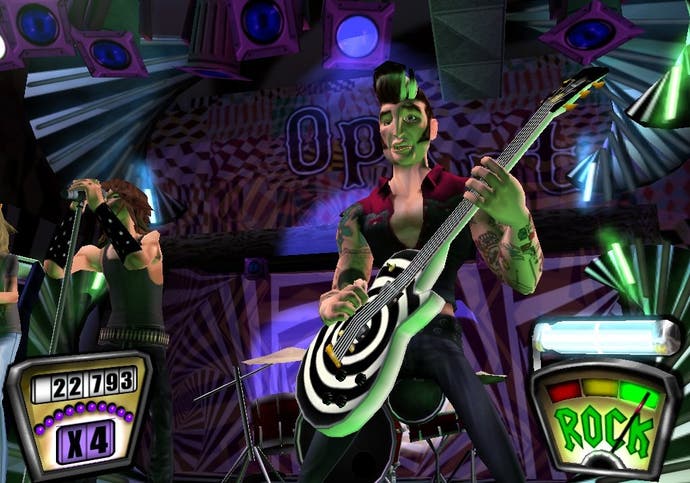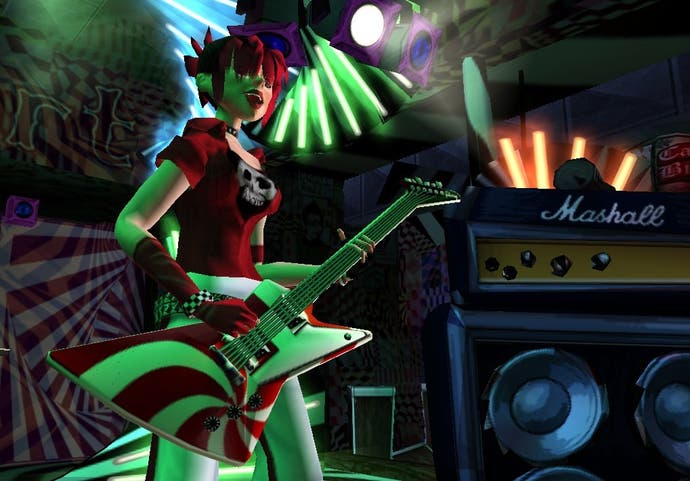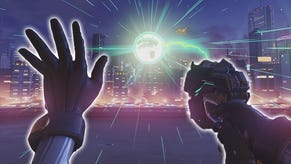Guitar Hero II
It's customary to try to be loudest during practice.
As the game rightly points out, you only need one person with a mohawk in your band. But do you only need one Guitar Hero game in your life?
Never mind that - did you even finish the last one? Because judging by the paucity of skilled axe-wielders in my gaming circle (myself somewhat included), not everyone really did. The basics are simple. Grip the fret button that corresponds to the colour of the note streaming down the screen and strum when it passes through a line at the bottom. But when a true master picks up Harmonix' custom Gibson SG guitar peripheral, the depth beyond that becomes apparent and not everyone got there.
It's the ultimate multi-tiered rhythm-action game. You can master the easy difficulty level in minutes, and you can master medium in a few hours. But neither equips you for the hard mode, which requires completely rethought finger behaviour, nor especially the expert mode, by which stage you'll need to bypass conscious thought to find the frets, and for which up-down strumming isn't just a preference, it's a precondition.
At least, it should be the ultimate multi-tiered rhythm-action game, but of the few complaints one could have about the original Guitar Hero, the most obvious is that bridging the gap between intermediate skills and those of the people whose YouTube videos mesmerise and depress in equal measure is very much a question of graft; the idea that those of us who didn't finish it were perhaps not entirely to blame for our eventual submission. Guitar Hero was punishing, with more solid brick walls than your local indie venue. Guitar Hero II promises 64 new songs, and the exciting co-operative mode that's headlined the press literature, but judging by a few hours in its company, one of the biggest improvements is the proficiency with which it coaches you, or allows you to coach yourself to stardom, compared to its rightly celebrated predecessor.

Important concepts like hammer-ons and pull-offs, which are methods of playing notes in quick succession without strumming individually, are taught quickly and enjoyably in the expanded Tutorial mode. (There's also a tweak there for the observant - the latter no longer requires the lower note to be held.) And there's no longer any need to plough repeatedly through a taxing song to practice the part that always ends your session. Instead, a new Practice option under the Training menu allows you to pick unlocked songs and work on specific elements of them - particular verses, bridges, choruses or solos - and play at different speed settings to help master the fingering. You can even go straight to Practice mode if you fail to complete a song in Career mode.
Progression is more fluent also thanks to the way component skills are introduced in a more sensibly layered manner. In our few hours in Guitar Hero II's company, we encountered less of those brick walls of difficulty, even though it felt that there was greater acceleration up the difficulty curve in terms of complexity. That, surely, demonstrates intelligent refinement.
Career mode is still the main event for budding axe-men, and the subtlety with which Harmonix has infused its less obvious qualities is matched by a loving hand out in the open. Those who enjoyed the original game's loading-screen notes will find all-new replacements. Remember - NO STAIRWAY! (Alas.) There are three new playable characters, and unlockable costumes for these and the eight of the returning cast, and each character now enjoys their own distinct animation routines rather than having to share, with more guitars available for them to wield - including Epiphone and Kramers along with the majority-Gibson selection. Venues are new, including a wonderful finale at Stonehenge (the Tutorial/Practice mode, incidentally, takes place in a guitarist's bedroom).

You receive cash signing bonuses as you move through the stages, and more interestingly at the end of each song you have a chance to review more stats. The scoring system is the same - giving you a review score out of five stars, a points score and a notes-hit percentage, but a More Stats button allows you to see exactly how many notes you hit out of the total number and note down your average multiplier level, while it even offers an in-depth dissection of your hit-rate throughout each of the verses, choruses and so on.
The most notably different Career and general game content, of course (or so you thought until this preview went for a wander in paragraph two), is the revised track listing. The final line-up is now known, and there are some huge songs on there - both historically and just in terms of length - like Sweet Child O' Mine, Monkey Wrench, Killing In The Name, Hangar 18, Free Bird, Heart-Shaped Box and Misirlou, to name a swollen handful.
But Guitar Hero II, like Guitar Hero and Harmonix' other rhythm-action games FreQuency and Amplitude before it, has a masterful ability to drive your enthusiasm through gameplay as well as recognition - an argument driven home in emphatic (not to mention puntastic) fashion by the first game's More Than A Feeling, a song nobody around here remembers liking beforehand. This quality of endearing you to experience more than constituent material also brings a significance to the unsigned bands that make up the game's unlockable tracks. You may not have heard of them, and that may turn you off when you read about them on the Internet, but it's worth giving them a go. There were some truly great Guitar Hero songs in the unlockable listing last time, and Guitar Hero II boasts 24 unlockable tracks - far more than the 15 originally quoted.
As before, the facsimile recordings are of a consistently decent standard, and this has actually improved in recent builds of the game. Where once Rage Against The Machine's Killing In The Name was a good but limited impersonation, it's now much more convincing, and anybody who has encountered demos of the game at Leipzig's Game Convention, E3 or another gaming event might want to look again.

The focus for those events and for a lot of the pre-game build-up has been the changes to multiplayer, which now offers a co-operative mode where one player takes the lead guitar role and another plays either rhythm or bass depending on the song. Collaborating on a song is a wonderful feeling, whichever part you play, with consistent care and attention in the gameplay make-up no matter the choice of fret-board. The only slightly disappointing thing is the absence of a co-op career mode, or the ability to play through single-player as a bassist or rhythm guitarist - but as a means of extending the game's value for groups their inclusion is welcome.
Alongside co-op, the sequel also offers the more traditional multiplayer Face-Off mode, where you each play a section of the song one by one and then tally scores, while an unlockable Pro Face-Off mode allows you to duel throughout the entire song. It's during these pitched battles that you may come to appreciate another new addition - the way the screen judders when you miss a note and break a streak. It sounds a bit throwaway, but it's actually a useful 'tell' in multiplayer, alerting you to another player's difficulties without forcing you to glance across, which is often near-impossible on the higher difficulty settings.
That change, among many others, typifies an approach that seems to fly in the face of musical game convention. Where often direct sequels (the entire SingStar range, most notably) struggle to expand on the original premise, Harmonix appears to have listened hard and looked closely at where its formula is weak. There's a 480p progressive-scan mode, and the developer has even included a new calibration option - the latter allowing those of you with high-end televisions, who may otherwise notice slight responsiveness issues, to play a few notes based on visual cues which then tell the game whether it's necessary to off-set its timings and by how many milliseconds.
It speaks of a love that we all felt playing Guitar Hero - not our own love for it, which can be almost taken for granted, but the love that stared out from it; worn on the sleeve of every bopping crowd-member's hoodie. There isn't long to go now until Guitar Hero II's 24th November release date, and while only an extensive playtest will validate our first impressions, there's certainly enough evidence of improvement in our initial experience to suggest that your pre-orders are safe bets. It looks like you really do need another Guitar Hero game in your life.
Guitar Hero II is due out in the US on 7th November, with a European release following later on 24th November. An Xbox 360 version is due out next spring.




